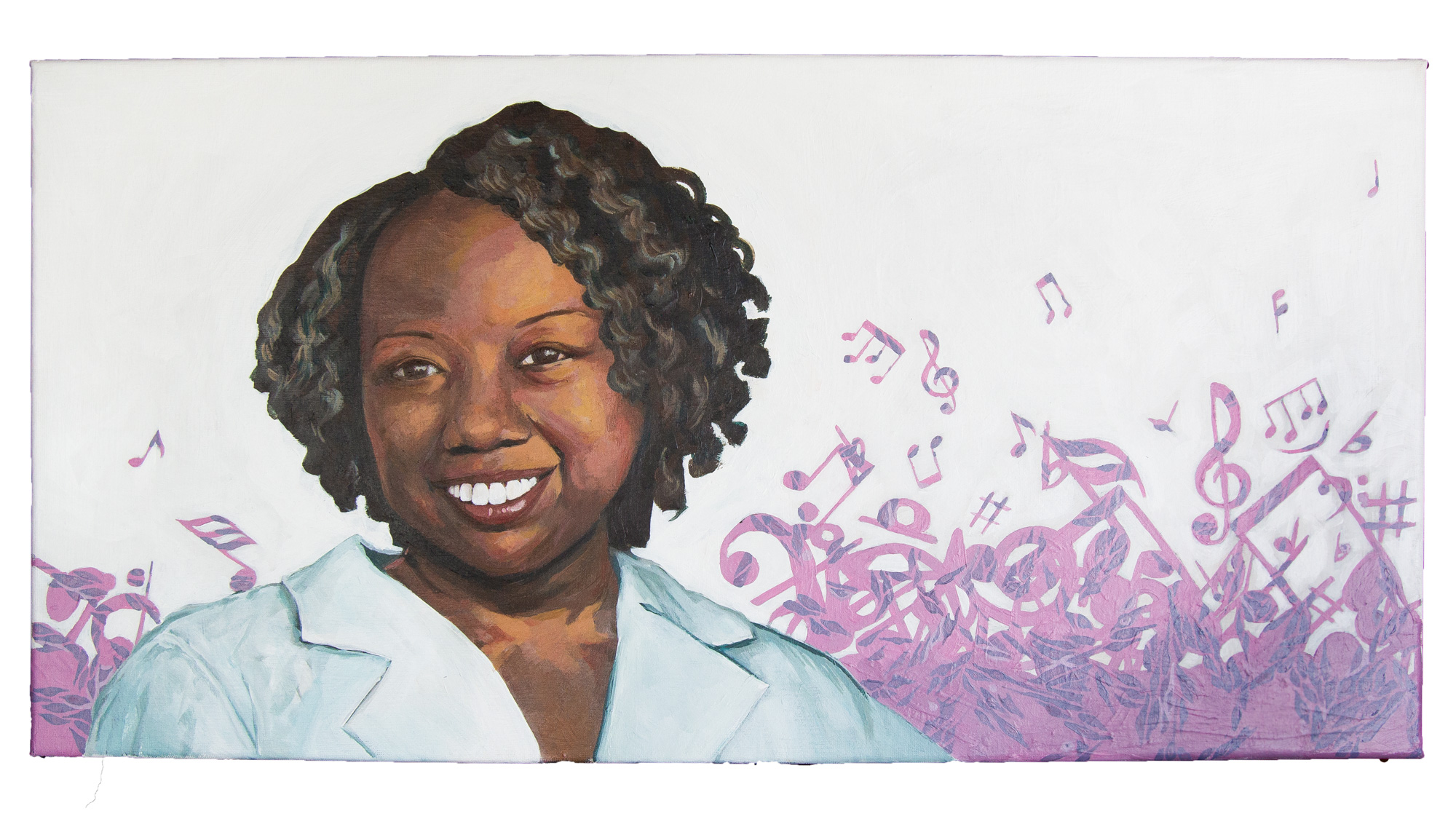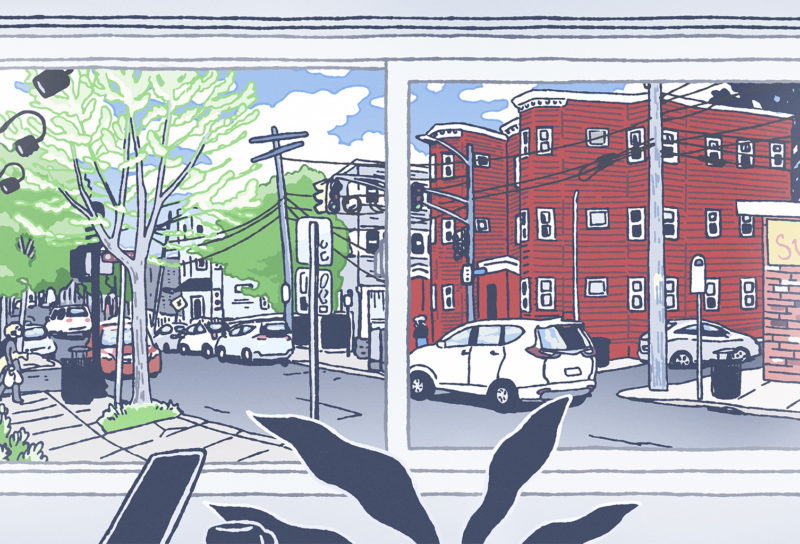There are many ways to consider a cell — from the astonishing fact that each of us began as a single one and now we are composed of trillions, to the discovery that some of the neurons in our spine stretch up to three feet. Karmella Haynes, a 43-year-old biomedical engineer at Emory University in Atlanta, Georgia, thinks of each cell as a choir, with every gene in it contributing its own voice. Genes in cells, she explains, “have innately different magnitudes of expression, like volume and pitch, and the rhythms of the percussion. Some are very quiet, others very loud. Healthy, happy cells are constantly making adjustments to the expression of these genes.” The result? A lovely harmony, and a well-functioning cell.
Cancer, she says, scrambles the whole arrangement. A cancer cell turns up the volume of certain genes and turns down the volume of others. The cell replicates too quickly, or starts breaking attachments with its neighbors, allowing it to wriggle away and bolt through the bloodstream to seed distant organs. For the last ten years, Haynes has been hard at work building a synthetic molecule that she hopes will cause cancer cells to stop ruining the song — and either lead them quietly back to less disruptive behavior, or simply allow them to fall silent altogether through apoptosis. She has engineered a protein that can upregulate the activity of protective genes shut down by cancer cells.
Her protein molecule is designed to lock onto target points in the tightly coiled packaging that shrink-wraps and coils all of the DNA inside each cell. The goal is to open that packaging in places where helpful genes, such as tumor suppressors, have been essentially smothered — letting them sing again. If Haynes’ molecule works as she hopes, cancer cells will start looking and behaving more normally — and will also die when damaged. We will be one step closer to curing cancer, restoring cellular harmony for good.
What drives a person to take on one of the world’s most deadly diseases? What’s the story behind this possibly revolutionary new treatment? I sat down with Karmella Haynes to find out.
Against Relentless Discrimination
Haynes’s story is unfortunately rare in synthetic biology: a young Black woman, with roots in “the Jim Crow Deep south,” rising to the top of an overwhelmingly white and male field. She is the sole African-American author on 29 of her 31 co-authored papers, and this is no coincidence. Haynes’ background primed her to beat massive odds. She grew up in St. Louis, Missouri, listening to her mother’s recollections of segregation, poverty, and the terrorism of the KKK. Remaining cognizant of that oppression was always as important to Haynes as outgrowing the limitations it imposed.
She received a full scholarship to Florida A&M — a public, historically Black university in Tallahassee, Florida. As an undergraduate, she was admitted to a summer research program at MIT geared toward under-represented minorities and the economically disadvantaged. She recalls heading straight for the bookstore when she got there. “I bought my dad an MIT sweater and mug,” she says. “He had dreamed of going to MIT as a high school student, but given the social inequities of the time, nobody took him seriously. My tribe is the folks from the southeast who were subjected to relentless discrimination. Many are still struggling to become more represented in areas like science.”


Haynes faced discrimination, often shrouded in “polite neglect, letting you suffocate under the weight of lost opportunity,” at key turning points in her life. She remains puzzled, for instance, at the “soft denial” of tenure at Arizona State University, where she was on the faculty in the School of Biological and Health Systems Engineering. “They never gave me a clear-cut reason,” she says. Haynes had raised a million dollars in grants, given the requisite number of national and international talks, taken on a heavy teaching load, been invited to help found a series of talks at the prestigious Cold Spring Harbor Laboratory, and published in medium and high impact journals. She had also, for the first time in the university’s history, invited freshmen students work directly with DNA. “They told me,” she recalls, “that I needed to present more evidence I could lead a sustainable research program.”
Haynes was also initially denied NIH funding for a post-doc position in the Harvard laboratory of prominent synthetic biologist Pamela Silver. Silver says that Haynes was more than qualified, a perfect fit. “I was just shocked,” says Silver, “because at the time the NIH was claiming they were trying to diversify science. I called them and then wrote them a letter and they overturned their decision and she got the fellowship.” Haynes says that was the first time “I had someone stand up for me like that, and I am so grateful. There is still a widespread, deep dismissal of the value of people because we are Black.” The new position would turn out to be a critical turning point in her career.
Haynes is now leading the way for others. She is an important voice in the synthetic biology world and considered a cancer researcher to watch. But her ancestry, and the history that was imposed on them, is never far from her mind. She remembers being afraid to walk down College Street at Arizona State University after a Black female colleague was brutalized and arrested by a police officer, who had stopped her for supposed jaywalking. The incident made national news, and had a lasting impact on her.
In 2009, Haynes began to gather genealogical and historical data on antebellum plantations, farms and factories that used African slave labor. She calls the site Sankofagen, which means to “go back and take” in the Akan language of Ghana. “So far I’ve discovered three plantations that I am connected to in Mississippi,” she says. A new connection with a distant cousin and author gave her the opportunity to write the foreword to his genealogy book, The Akee Tree. “I want to assist those who, like myself, face the brick wall of slavery as we try to trace our lineage.”
She traces that lineage in artwork too. She paints portraits drenched in color and tinged with surrealism, some of them referencing the names of gods and goddesses in the African Yoruba religion. She aims to blur the lines between the mundane and magical. “So-called “magic” is all round us,” she says. For Haynes, science and art both communicate things that are not immediately obvious, and both have presented her with the same challenge: “Do I mirror what everybody else is doing—or do I take a risk?”


A Dynamic New Approach to Cancer Research
On both counts, Haynes has successfully erred on the side of risk. Her research involves tweaking chromatin, a complex of proteins that attach themselves to DNA and wind and coil it like a garden hose, making it compact enough to fit into a cell. A stretch of DNA that is nearly 6 feet (2 meters) long can be wound into a string of chromatin ‘beads’ that cluster and fold into a space that is merely one one-hundredth of a millimeter wide. But it turns out that chromatin is far more than just amazing packaging. It is actually the guardian of gene activity. The way it works is simple but ingenious: it can temporarily uncoil in places, opening up to allow proteins and enzymes into the cell to turn up the volume and activity of certain genes. It can also pack down, quieting or silencing specific genes. Chromatin modifies the “tune” and volume of the songs our genes sing.
Modifying chromatin is a relatively new focus in cancer research, but has already led to novel drugs that are distinct from those that target mutated genes or cancer-promoting oncogenes. Chromatin is fundamental to every activity of a cell, because it allows cells to make epigenetic changes — to change their function, while leaving the genetic code the same. Haynes is fascinated by epigenetic changes because they modify the way a cell behaves and in some cases can be permanent and inherited by future generations. She thinks medical advances that focus on epigenetic modulation will eventually lead to “a revolution in cancer treatment.”
Though cancer cells contain critical mutations, many genes in a cancer cell are perfectly normal — only the chromatin packaging is changed. Permanently quieting protective genes, or turning up the volume on genes that help a cell reproduce or resist dying, enable a cancer cell’s seemingly reckless growth. “If a cancer cell only used DNA mutations to change its personality,” Haynes explains, “it might end up mutating a gene it needed in order to live. Cancer cells need a lot of the same genes that healthy cells need in order to stay alive.” That insight, she says, is key to a new generation of designer molecules that target gene expression, not mutations.
According to Pamela Silver, “Karmella is doing something no one had done before. She is blending chromatin dynamics and synthetic biology. I’m just kind-of in awe of her.” Another mentor, biologist Malcolm Campbell of Davidson College, agrees: “She’s trying something really hard, and if she is successful it’ll have a huge impact not just on synthetic biology but on all of cancer biology.”
So far, so good: in 2011, Haynes and Silver published a paper proving that her synthetic molecule can indeed target chromatin and reactivate silenced genes, so that cell proliferation is reduced. She has had promising results in a bone cancer cell line. Her work on breast cancer cell lines as an independent investigator in 2017 shows that her protein activates immune-boosting genes, which are known to stimulate the body’s own interferon response to fight off viruses and kill cancer cells. Now in 2020, she is ready to embark on her first mouse study, to see if her protein can actually shrink tumors in living animals. In the best of all possible worlds, she says, Pc-TFs might prove useful in one of the most untreatable cancers in the world, triple-negative breast cancer. It’s an aggressive cancer with few options, but one in which many protective, tumor-suppressing genes are silenced. “Reprogramming cancer gene expression profiles,” she says, “and therefore changing the production of proteins within cancer cells, could be particularly useful for hard-to-treat cancers that lack sensitive drug targets.”

A Fortunate Mishap
Haynes arrived at her chosen niche in synthetic biology through what she calls a “fortunate mishap.” Her current focus blossomed out of a failed thought experiment while she was in Silver’s lab — an experiment in which she planned to modify chromatin in order to design a new self-contained epigenetic switch. “In the summer of 2009 I had this super-fun idea to take a protein that was naturally occurring in human cells and use it to build a circuit type system where the protein would land on a gene, turn it on, but have no effect on other genes in the cell.” If all went well, the protein would land on a little tag, rising up off a particular histone, a tag called H3K27me3 that had been placed near a synthetic gene. She had already begun to piece together her synthetic DNA when a colleague at a lab meeting pointed out that her protein was likely to land at many other H3K27me3 markers on chromatin, activating so many genes it would substantially affect the cell. Devastated at first, Haynes says she soon realized that “if this protein can switch on genes and alter cell behavior, it would be a great treatment for cancer.” In fact, the H3K27me3 marker had recently been linked in multiple papers to tumor suppression in cancer.
Haynes decided to work with a bone cancer cell line she had been using for some projects, and look for the H3K27me3 marker. It was indeed present at several genes that were activated by her synthetic protein. Even better, she saw activation of these genes, which included an important tumor suppressor called p16. At the same time, she observed that the cells became senescent, losing their ability to replicate as quickly.
Her 2011 paper on that work had just been accepted when she attended a synthetic biology conference at Stanford, and decided to hand-paint a poster of her discovery on canvas — not the typical scientist’s “poster” session. “I was completely blown away,” Stanford evolutionary biologist Jonathan Eisen blogged of his encounter with her. “She had her paints with her and was continuing to add touches to the painting” as they talked about her discovery.
What lies ahead for Haynes and her cancer revolution? “Traditional drugs are made of small molecules,” she says, and though they can be effective and are easy to deliver into a patient, “they don’t encode a lot of biologically relevant information. They rely on interrupting or enhancing a protein that is already there.” They can’t reach the level of sophistication that is possible with engineered proteins that are big, complex and diverse. With synthetically engineered proteins, she says, there is potentially far greater power. “You can string together different parts with different functions to make a customized biological nanomachine.”
The key is understanding that a cancer cell can achieve dramatic changes in its gene expression, and thus its behavior, simply by turning the volume of genes up and down.
KARMELLA HAYNES
There will be big hurdles and challenges, she acknowledges, even if her protein works beautifully. “There’s always the chance that it will artificially activate a gene at the wrong time in the wrong place in a healthy cell, and stop it from functioning,” she explains. If that were the case, she might have to add an additional biochemical cancer-homing tag onto her protein, rendering it larger. And the larger a molecule, the more challenging its delivery. An engineered protein can’t be so large that it is tough or impossible to get into cells.
Haynes’ colleague Carlos Moreno, a specialist in cancer bioinformatics and systems biology at Emory University School of Medicine, agrees. “It’s likely you will have to package these proteins in some sort of liposome or targeted nanoparticle to get them into the cell,” he says. But ultimately, Moreno says, an approach like Haynes’ can be of great value, especially combined with other therapeutic options. “With any cancer therapy, some cells will be vulnerable, but others may not be.” Tumors are full of diversity, and it is “always a challenge to combat the ever-present challenge of resistance.”
Looking forward, Haynes says a best-case-scenario might result in a drug a decade from now. The key, she says, is understanding that a cancer cell can achieve dramatic changes in its gene expression, and thus its behavior, simply by turning the volume of genes up and down. She’s not surprised: “That is exactly how the cells in different tissues take on different personalities — how one becomes a red blood cell, and another becomes a neuron.” This is the way the songs of life itself are composed. New techniques in synthetic biology offer us novel ways of hearing and harmonizing those melodies, so they remain true, clear and beautiful.



